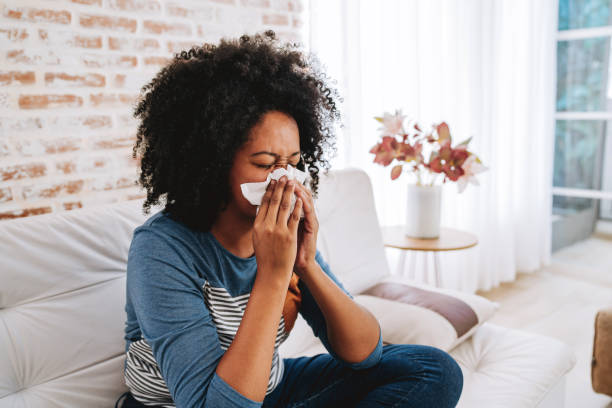
According to the Asthma and Allergy Foundation of America (AAFA), in 2021, approximately 81 million people in the U.S. were diagnosed with seasonal allergic rhinitis (hay fever). This equals around 26 percent (67 million) of adults and 19 percent (14 million) of children.
“Although allergies are largely attributable to a combination of genetic and environmental factors, there are a number of health behaviors you can adopt to positively impact the way your body responds to internal and external triggers,” said Kim Tuck, RN, President and CEO of NurseWise.
Seasonal allergy symptoms
- Congestion
- Sneezing
- Itchy eyes, nose and throat
- Runny nose and eyes
- Post-nasal drip (drainage in the throat)
- Fatigue
- Coughing
What are the most common seasonal allergens and when do they occur?
- Tree pollen—March/April
- Grass pollen—June/July
- Ragweed—Fall
- Mold—Fall
Not all environmental allergies are seasonal. So-called “perennial allergies” can affect you all year long. They include allergies to cat hair and dust mites, according to Yale Medicine.

Managing your symptoms
Consider the following tips to manage your body’s response to triggers:
1. Consider allergy testing.
Consult your PCP, allergist or medical provider of choice to find out about the benefits of allergy testing. Allergy testing allows your medical provider to pinpoint the specific triggers that your body responds to and the severity of your reaction. Allergy testing has come a long way in the past decade, and once you know what works well with and for your body, you and your medical provider can create a specific plan to increase your level of comfort during allergy season.
2. Reduce your exposure to outdoor allergens.
You should stay indoors as much as possible on dry and windy days. The best time to go outside is after a good rain. The rain helps clear pollen buildup on automobile surfaces and other stationary outdoor spaces. Reduce mowing the lawn and other gardening activities that increase exposure to pollen and other environmental stimulants. Don’t hang your laundry to dry outside to avoid pollen adherence to clothing and linens.
To reduce your contact with seasonal allergens, consider:
- Checking daily pollen and mold counts and avoiding outdoor activities when they are high (resources like the American Academy of Allergy Asthma & Immunology’s allergen tracker can help).
- Beginning allergy medications before the season starts.
- Keeping indoor spaces and vehicles sealed by closing windows and doors.
- Protecting hair from pollen by wearing a hat outside and washing it before bed.
- Changing clothes after outdoor activities.
- Avoiding tasks like mowing or raking, or wearing a mask while doing them.
3. Keep a daily pulse on allergy counts.
Seasonal allergy signs and symptoms can flare up when there’s a lot of pollen in the air. Make sure to check your local TV or radio station or download an app to check the current pollen count. Pollen counts are at their peak in the morning, so try to limit outdoor activities during peak pollen times.
4. Keep indoor air clean.
Unfortunately, no miracle formula will magically eliminate all allergens from the air surrounding you. But taking steps like using the air conditioning in your home and car can improve the quality of the air you breathe. To make the use of air conditioning even more effective, use high-efficiency air filters and change them per the manufacturer’s guidelines to ensure the best quality air flow. Lastly, keeping your carpets and floors clean and dust-free will eliminate allergy-inducing pet dander and debris.
RELATED: 10 Common Asthma Myths Debunked
5. You are what you eat.
Many people fail to realize that certain foods can heighten allergic responses and increase inflammation. Start keeping a watchful eye on your food intake. When you notice symptoms like nausea, headache, dizziness, or an itchy throat or wheezing, take note of the foods you’ve consumed. You may notice a trend that the foods you’re eating are additional culprits and irritants in your battle against seasonal allergies. Avoid dairy products, chocolate and added sugars when you’re experiencing an allergic flare or considering an outdoor adventure. Also, be sure to drink plenty of water to keep your body hydrated and best positioned to detox and fight inflammation.
What are the common treatments for seasonal allergies?
Seasonal allergy relief typically involves:
- Antihistamines: Over-the-counter or prescription medications to reduce the immune response and alleviate symptoms.
- Decongestants: To help clear nasal congestion.
- Cough medications: Often recommended for cough relief.
- Nasal sprays: Prescription antihistamine or steroid sprays to calm the immune reaction in the nasal passages.
- Allergen immunotherapy: A longer-term treatment to build tolerance:
- Subcutaneous injections (allergy shots): Regular injections of specific allergens are administered by a doctor.
- Sublingual immunotherapy: Prescription tablets or drops dissolved under the tongue (currently for grass and ragweed allergies).
In conclusion, allergists play a crucial role in identifying seasonal allergy symptoms and developing tailored treatment plans. Their expertise extends beyond seasonal allergies to encompass a wide range of allergic and immunologic conditions, including chronic sinus issues, asthma, and complex sensitivities to foods and medications. Seeking the guidance of an allergist is essential for accurate diagnosis and effective management of the full spectrum of allergic disorders.
Visit the BlackDoctor.org Allergy center for more articles.









